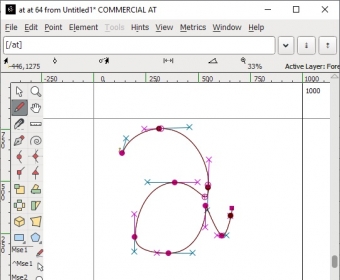
Otherwise I get B/W only, as far as I understand the whole issue. Some program actually has to do the COLR/CPAL decomposition.

Normal TT or PS glyph with some color assigned, SinceĮach "color sub glyph" (after the COLR decomposition) is just a Glyphs at their respective positions, colorized as needed. The SVG, sbix and CBDT proposals are all Rendering proposals so they need different handling.ĬOLR/CPAL are fully PDF- and print-stream compatible. Which is why the MS proposal is very backwards compatible. Because the COLR table is ultimately a special layout table while the glyph shapes are still sourced from the traditional glyf or CFF table. The way I see it, the Microsoft multi-color solution (COLR/CPAL) is more a Layout solution (HarfBuzz part) than it is a Rendering solution (FreeType part). When authoring a PDF, the layout engine does further decomposition via COLR and colorizes via CPAL.
FONTFORGE SPEED UP EDITING PDF
A PDF viewer does not need to have a complex script shaper for Devanagari because by the time the text gets to the PDF, all glyphs are fully decmposed, substituted and positioned, and - if you colorize the glyphs trafitionally - each glyph has its own color.

You decompose the glyphs while authoring the print stream or PDF. Reply to this email directly or view it on GitHub. However, the most crucial question is: How many PDF viewers canĪctually display the colours from fonts with COLR and CPAL tables? The last step is FontForge, and here we would need Would need an extension to write glyphs with different colours intoĭifferent fonts. The mf2pt1 script creates plain type1 fonts it Lilypond, however, basically all tools have to be adapted except theįirst one, metapost. It might be possible to add that to the font toolchain of To be red at the font level via the COLR and CPAL tables.

Where the red glyphs are not made red with markup but are specified A text "layer" is created with your text set using the outline-less font with the dummy glyf table, and then on a second "layer", at each position where a glyph occurs, the appropriate PNG is positioned. Since an sbix font requires a dummy glyf table with correct advance widths but no outlines, the sbix table is cut from the font, the font is sent to the PDF, the PNGs are taken from the sbix table, embedded into the PDF as normal graphic images.
FONTFORGE SPEED UP EDITING MAC OS X
This is in fact exactly what Mac OS X is doing when you make a PDF using an sbix font. There, the PDF authoring app has to pull out the glyph descriptors as graphical assets, store them as separate resources in the PDF, convert the font so that it includes dummy outline-less glyph descriptors, lay out the text using that font and then position each of the glyph graphical assets "underneath" each appropriate glyph position. It's different with the other formats like sbix or SVG in SFNT. Since a PDF viewer is not expected to perform any layout, all should work without problems. You just embed a simple Type 1, CFF or Type 42 font in the PDF, and render a laid out glyph stream. Since each "color sub glyph" (after the COLR decomposition) is just a normal TT or PS glyph with some color assigned, PDF doesn't need to know anything about COLR (just like it doesn't need to know anything about GPOS or GSUB). Now you do GSUB, GPOS, COLR and render the glyphs at their respective positions, colorized as needed. Before COLR, you'd do GSUB, GPOS and you'd then render the glyphs at their respective positions. The COLR table is in a way very similar to the GSUB one-to-many lookups. COLR/CPAL are fully PDF- and print-stream compatible.


 0 kommentar(er)
0 kommentar(er)
